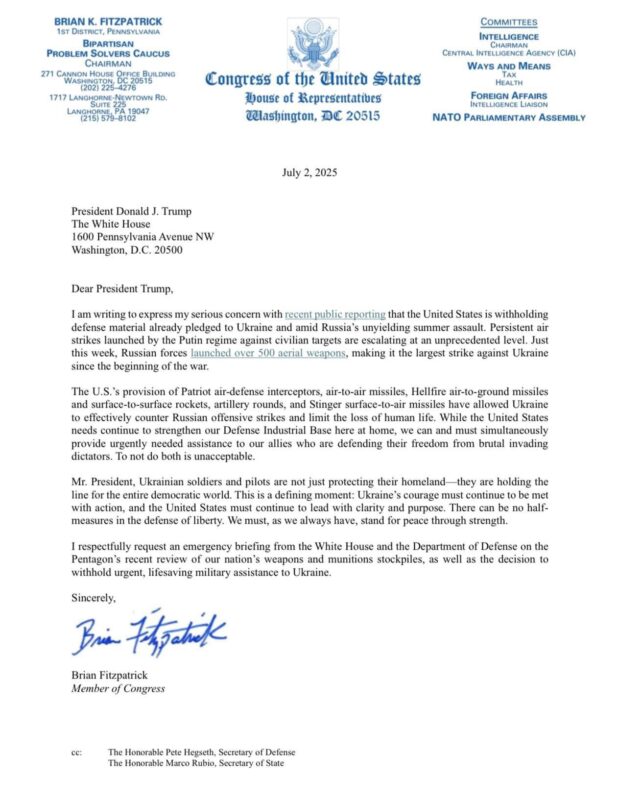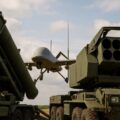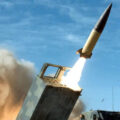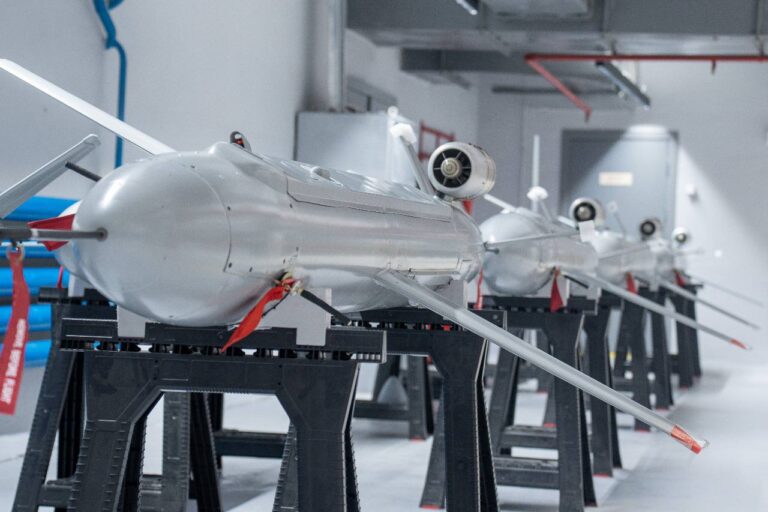
US Suspension of Military Aid to Ukraine: What’s Happening and What It Means
In July 2025, as Russian attacks on Ukrainian cities once again became a daily reality, a piece of news emerged in the media that truly alarmed both the government and society. Official Washington announced the suspension of part of its military aid to Ukraine. This signal became a catalyst for political debate in the United States and, for Ukraine, another reminder of how fragile international support can be in the midst of a major war.
Congressional Reaction: Why This Didn’t Go Unnoticed
One of the first to respond publicly to the news about the pause in arms deliveries was Republican Congressman Brian Fitzpatrick. He officially appealed to President Donald Trump, demanding an urgent briefing. In his letter, Fitzpatrick emphasized: such news cannot remain unexplained especially against the backdrop of Ukrainian troops holding “the frontline of freedom” while Russian missiles and drones attack civilian infrastructure. The congressman called on the White House and Pentagon to transparently explain the reasoning behind this decision and disclose the real state of U.S. weapons reserves. His main demand was to guarantee that America is not turning away from Ukraine but remains a reliable partner in defense and security. In his view, supporting Ukraine is not just about diplomacy, but about defending core values and peace through strength.

What Really Happened: Details of the Decision and Who Made It
According to American media and official sources, the suspension primarily concerns precision-guided munitions and certain air defense missiles. Some media connect the decision to the new Secretary of Defense, Pete Hegseth, but most sources name Elbridge Colby, who heads the Pentagon’s policy division, as the initiator. As Politico notes, this step was the result of a review of U.S. ammunition stocks Pentagon officials are concerned that strategic reserves are being depleted too quickly, especially amid new global challenges. Notably, the initial decision was made in early June, but it only became noticeable for the Ukrainian side now, just as Russian strikes intensified once again. The White House has officially confirmed that some weapons deliveries to Ukraine are temporarily suspended. Administration representatives stated that this decision is tied to ensuring the U.S. retains its own defense capabilities and avoids shortages of critical defense assets.
Ukraine’s Reaction: Diplomacy Amid Uncertainty
Ukrainian agencies reacted immediately: the Ministry of Defense appealed to the Pentagon for clarification, and the Foreign Ministry summoned the acting chargé d’affaires of the U.S. Embassy. At the time of the decision, no official notification about the suspension had been sent to Kyiv. This is yet another reminder that even among partners, transparency is not always absolute. Meanwhile, the White House confirmed: the pause concerns some high-tech weaponry. U.S. officials in Washington explained that this is a “temporary measure” and that America remains committed to supporting Ukraine, but wants to ensure its own stability.
How U.S. Support Has Changed Since Trump’s Return
Since President Donald Trump took office, the situation with military aid has changed significantly. Ukraine no longer receives new large packages of assistance what is being used now is only what remains of the $61 billion approved under President Biden. In practice, new arms deliveries have become rare exceptions: only in May did the State Department approve, for the first time, a contract to sell arms to Ukraine worth $50 million. Additionally, packages were approved for F-16 maintenance and the transfer of missiles from Germany. However, Ukraine is already negotiating a new format of relations with the U.S. purchasing arms instead of receiving them as aid. As President Zelensky has said, Kyiv insists on expanding cooperation in both defense and the economy, including a possible free trade agreement.
Why This Pause Is Especially Dangerous Right Now
The suspension of military support coincides with one of the most difficult phases for Ukraine in this war: Russia has increased the number of attacks on civilian and critical infrastructure, and the Ukrainian Armed Forces have an acute need for modern air defense systems and precision-guided munitions. Pauses in deliveries could critically affect the country’s ability to defend its cities, energy systems, and civilian lives. Delays or cuts in U.S. support also send a signal to other partners: is America still ready to lead in supporting Ukraine, or is it gradually shifting focus to its own needs? For Ukrainian society, this increases anxiety and uncertainty, and for the military, it complicates defense planning.
Prospects and Risks: What’s Next
The pause in arms deliveries is not just a tactical episode, but a symptom of a more complex political debate in the U.S. about its strategy toward Ukraine. The fate of further support largely depends on the political will of the White House and Congress. Meanwhile, for Ukraine, the ability to negotiate commercial arms deals, build up its own stockpiles, and seek support from a wider range of partners is becoming increasingly important. In these conditions, Ukrainian authorities must act proactively: strengthening diplomatic work in the U.S., forming clear arguments for Congress and the public, and accelerating the development of Ukraine’s own defense industry.
The suspension of U.S. military aid is not just a bureaucratic formality but a serious political signal and a test of the strength of partnership. The speed of response, diplomatic flexibility, and the resilience of Ukraine itself now determine whether support from Washington will remain systematic and predictable. The situation remains tense, but it is in such moments that experience is gained that can shape the country’s security future.













